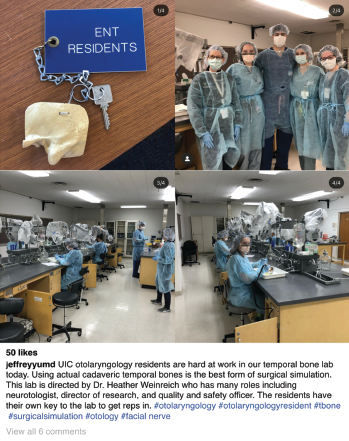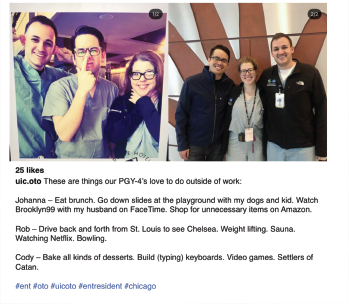Every year, medical students undergo a rite of passage by entering into the National Residency Match Program to determine their future career path, education, and living location. Medical students interested in becoming otolaryngologists are no different. The 2021 match was unique in that COVID-19 put a stop to normal activities that allowed residency programs and students to make informed and confident decisions in terms of rank lists. To provide applicants perspectives into life as a resident in these programs, academic otolaryngology departments turned to social media to provide residency information through posts and images.
Explore This Issue
January 2022Visiting student electives, conferences, and in-person interviews have all been victim to the COVID-19 cancel culture. During a visiting student elective, students and faculty have longitudinal interaction and contact to develop in-depth knowledge of each other’s attributes. The cancellation of in-person interviews and conferences prevented students from developing personal relationships that allow their unique characteristics to stand out. Zoom or online interviews allow face-to-face communication but lack subtle nuances of body language, posture, emotion, and true eye contact. As a result, both otolaryngology residency programs and prospective residency applicants were faced with a challenging task of creating rank lists because a lack of in-person experience and interaction with each other.
Turning to Instagram

Figure 1. © Courtesy John Wilson IV, MD
To increase available information to applicants, otolaryngology residency programs turned to social media, especially Instagram. As of the beginning of 2021, almost 75% of programs were participating. This smart phone-based technology allows residency programs to post a variety of pictorial content. In contrast to a static residency website that’s dependent on the frequency of updates, social media content is generated as events unfold and captures the emotion associated with the moment. The focus on candid photos and images creates and conveys ideas, values, personalities, and interpersonal interactions that are both genuine and unique.
Examples of this type of content are depicted in Figures 1 and 2. Figure 1 demonstrates the educational activity of temporal bone dissection in the department of otolaryngology at the University of Illinois at Chicago. While this post illustrates a very common educational activity and its environment, it focuses on the residents as a close-knit team, their enjoyment of the activity, and the importance of faculty participation.
I can add content and my perspective to support the messaging and values demonstrated by our resident account. By using the tagging function, my content can be amplified to reach a larger audience. —Jeffrey Yu, MD
Figure 2 is a post that introduced the PGY4 residents of the residency program at the University of Illinois at Chicago as unique individuals who are real, fun people who love otolaryngology. The focus of the post is to emphasize the value of work–life balance. Instagram has been a unique experience for both medical students and residency programs and represents an opportunity for academic otolaryngologists to enter the online world and reach out to future members of their field.
The Medical Student Perspective
The current generation of medical students already frequent Instagram to keep in touch with friends and to admire interesting people. However, current otolaryngology faculty of residency programs are from a generation that’s much less familiar with social media. Offering medical students a means to learn more about residency programs via Instagram demonstrates one generation reaching out to the future members of the field. In Dr. Curran’s experience as a medical graduate in 2021 looking for a residency, finding a residency program’s Instagram account and scrolling through its post history was often more helpful than visiting the program’s website.

Figure 2. © Courtesy John Wilson IV
Initially, Dr. Curran wasn’t sure what he was looking for, but after viewing multiple Instagram accounts, it became clear: He noticed which programs posted more about their residents, whether it was a personal spotlight, a highlight of an accomplishment, or an announcement of future plans. He also sought posts depicting social events to form an impression of whether or not he would fit in with that residency’s culture. Traditionally, students would have the opportunity to more comprehensively learn about these aspects of residency programs via visiting student rotations, though this Match cycle’s unique challenges precluded this opportunity.
Dr. Curran noted that following these Instagram accounts was also helpful for staying informed about these programs as the 2021 application season progressed. Instagram ensured that residency candidates were aware of information sessions, opportunities to meet current residents, and other important announcements—some of which were exclusive to Instagram.
Of course, using Instagram for information about residency programs comes with limitations. Dr. Curran said that candidates must be aware of the curation intrinsic to social media platforms like Instagram—they’ll only see the good things. In addition, even if a residency program has an official account, candidates shouldn’t assume that all important residency-related information and announcements will be communicated through Instagram. This strategy should be a supplement to, not a mainstay of, the Match process.
The Academic Otolaryngologist Perspective
Even though Dr. Yu is a member of the millennial generation, he has avoided popular trends such as Twitter, Instagram, and other forms of social media. However, as he watched the evolving landscape of residency programs joining Instagram, he recognized the advantages of this technology to illustrate his role in an otolaryngology residency program available to prospective applicants.
He can add content and his perspective to support the messaging and values demonstrated by the university’s resident account. By using the tagging function, his content can be amplified to reach a larger audience. Putting in the work to create the content can be done efficiently and in real time using a smart phone; his academic practice naturally produces the content. For example, in his department, Dr. Yu serves as undergraduate medical education director, and he has been able to use Instagram as a platform to communicate his education initiatives, publications, and passion for otology and endoscopic pictures of the eardrum to students.
The greatest reward, though, has been the online comradery. A common theme on otolaryngology residency accounts is to post on the resiliency of faculty, residents, and staff as they navigate the COVID-19 pandemic. Posts follow them as they continue to provide patient care, fulfill educational missions, and promote wellness in the face of the risk of contracting the virus, the need to social distance, and moving to online teaching.
The focus on candid photos and images creates and conveys ideas, values, personalities, and interpersonal interactions that are both genuine and unique.
In one pandemic year, otolaryngology residency programs made the leap to social media as a technology that facilitates easy dissemination and publication of information. Text and pictures become profound messages to an audience of followers. Current generations of academic otolaryngologists can connect with younger members and provide information about their faculty profile that is authentic and immediate. Future generations of otolaryngologists will continue to participate in social media in a professional manner, and this technology will foster ongoing connection in our greater otolaryngology community.
Dr. Yu is an assistant professor in the department of otolaryngology at the University of Illinois in Chicago (UIC). Dr. Curran is an otolaryngology resident at the University of Cincinnati. Dr. Wilson is an otolaryngology resident at UIC.